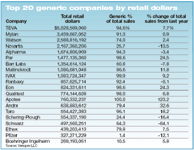Generic pharmaceutical industry growth slows a tad
The generic pharmaceutical industry has hit some speed bumps. Sales by individual generic drugmakers such as TEVA continue to soar, but the industry as a whole is growing about 10% annually. That's not bad compared with the 6% annual growth the typical brand-name drugmaker is logging. But it's a far cry from the 20% to 50% annual growth generic firms have been accustomed to seeing in the past.

"Some companies are doing fine," said industry consultant Ed Thwaite. "Others have announced they're not as strong as they could be. The generic business is still going to be a healthy industry, just not as healthy as everyone imagined a couple of years ago."
In 2002 and 2003, the generic industry was almost euphoric. Dozens of brand-name products were coming off patent just as an aging population was pushing drug utilization skyward and price worries were driving private and government payers toward generic alternatives. None of those factors has changed, but after years of breaking one growth record after another, the euphoria is wearing off. Industry talk in 2005 is less about continuing the winning streak and all about strategic planning for the future.
GPhA is focusing its efforts in three areas. The No. 1 policy priority is clearing a regulatory path for the approval of generic biopharmaceuticals such as generic insulins and growth hormones. No. 2 is beating back the spread of authorized generics, arguably the most successful tactic brand-name drugmakers have discovered to protect their own income streams. No. 3 is keeping the door firmly closed to drug imports and price controls.
It's not that the generic drug industry is in bad shape, noted Doug Long, VP of industry relations for IMS Health. Over the past three years, generic Rx volume and generic dollar sales have been growing by at least 10% annually, he said.
Generics now account for better than half of all Rxs written and dispensed in the United States. According to GPhA, the average price for a brand-name drug is $84.21 versus $30.56 for a generic. As more patents expire on more brand products, there is no reason to expect generic Rx volume or sales volume to do anything except continue to grow.
Market research firm Cutting Edge Information predicts that both generic Rxs and sales will continue to increase 10%-15% annually over the next five years. In the next 12 months alone, generic firms are gearing up for patent expirations on Zithromax (azithromycin, Pfizer), Zofran (ondansetron, GlaxoSmithKline), Biaxin (clarithromycin, Abbott), and Rocephin (ceftriaxone, Roche), Long noted. All four products are $500 million-plus sellers.
Long added that generic makers are also looking forward to 2006 and patent expiration on Zocor (simvastatin, Merck), one of the juiciest generic targets in years. Merck's lipid-lowering blockbuster is currently the No. 6 best-selling brand-name drug by Rxs (23.8 million in 2004) and No. 3 by sales ($3.2 billion).
So why the gloom and worried looks? For starters, Thwaite pointed to negative publicity surrounding COX-2 inhibitors Vioxx (rofecoxib, Merck), Celebrex (celecoxib, Pfizer), and Bextra (valdecoxib, Pfizer). The association of COX-2 inhibitors with increased cardiovascular risk and mortality has dimmed the prospect of future sales of either branded or generic versions. None of the three products is up for patent expiration in the near future, but none looks to produce the strong sales generic makers expected just a year ago.